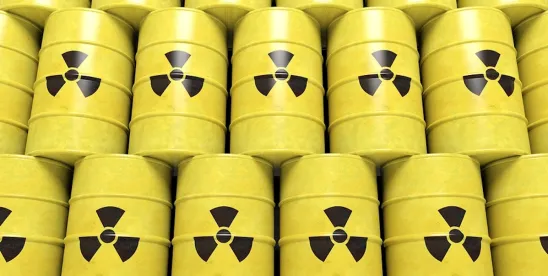On June 18, 2025, the U.S. Supreme Court, in NRC v. Texas, issued an opinion holding that the State of Texas did not have standing to challenge a license granted by the Nuclear Regulatory Commission (NRC) to a private entity, Interim Storage Partners (ISP), to operate a private off-site storage facility for high-level radioactive waste.[1]
While the majority did not formally address the merits of the complaint, its detailed response to the dissenting opinion (Gorsuch, J., dissenting, joined by Thomas and Alito, JJ.), as well as a June 30, 2025 summary disposition on similar grounds of the related appeals in NRC v. Fasken Land and Minerals and Holtec International v. NRC, may signal support for NRC licensing of interim private off-site storage facilities for high-level radioactive waste.[2]
Background on the Nuclear Storage Crisis
Spent nuclear fuel remains highly radioactive for thousands of years and can be very dangerous if not properly handled and maintained.[3] The issue of how and where to store this waste has been hotly contested for decades[4] and is especially relevant amid the new administration’s growing interest in nuclear energy.
The challenge of managing spent nuclear fuel garnered national attention beginning in the 1970’s and early 1980’s when the nuclear reprocessing industry collapsed after Presidents Ford and Carter implemented a freeze on potential reprocessing of spent nuclear fuel.[5] Since then, an estimated 100,000 tons of spent nuclear fuel has accumulated at commercial nuclear power plants nationwide, with more than 2,000 tons being added each year.[6]
Plans for a permanent national repository at Yucca Mountain, Utah contemplated by a 1987 amendment to the 1982 Nuclear Waste Policy Act (NWPA) were scuttled by Nevada residents and officials.[7] As a result, much of existing spent nuclear fuel continues to be stored on site at nuclear power plants.[8]
There is debate about the extent to which NRC licensing of “off-site” interim storage facilities has actually occurred, and the circumstances of that licensing. The recent NRC licensing of the Texas facility at issue, and another in New Mexico, has prompted challenges from states and landowners as to the scope of the statutes underlying the NRC’s licensing authority, culminating in the Supreme Court’s recent decision in NRC v. Texas.[9]
In NRC v. Texas, the question was raised as to (1) whether the NRC possessed statutory authority to license private off-site nuclear waste storage facilities broadly under the Atomic Energy Act of 1954 (AEA) and (2) if so, whether sections 10151(b) and 10155(h) of the NWPA, which provide that spent nuclear fuel must be stored either on site or at a federal facility and that “nothing in this chapter shall be construed to . . . authorize” private storage facilities, restricted the NRC’s authority.[10]
How Did the Court Address the Issue?
The majority declined to formally reach the merits, but nevertheless dedicated four pages of dicta to rebutting the dissent’s view that “[t]he answer [to the merits question] is not hard to come by.”[11] In doing so, the six-justice majority seemed to signal to interested parties how it might rule on private off-site interim storage of high-level nuclear waste in the future. The majority seemed to suggest that history and precedent support a broad reading of the AEA that would authorize the NRC to license interim private offsite storage facilities of high-level radioactive waste.
The majority first points to the NRC’s 45-year history of licensing such facilities, with spent nuclear fuel currently being stored at about 10 privately owned storage sites where there are no active nuclear reactors.[12] The NRC issued regulations in 1980 interpreting the AEA to authorize this practice and providing the necessary licensing procedures for it.[13] The majority reasons that Congress was well aware of both the AEA and the NRC’s licensing practices when it drafted the NWPA, and so it must not have intended to disrupt either of them.[14]
In terms of precedent, they argued that a 1983 Supreme Court opinion, Pacific Gas & Elec. Co. v. State Energy Resources Conservation and Development Comm’n, affirms the federal government’s extensive occupation of the “nuclear waste disposal” regulatory field.[15] At the same time, they rely on reasoning in an opinion by the D.C. Court of Appeals in Bullcreek v. NRC to construe the NWPA’s restrictions, which begin in part with “nothing in this chapter shall . . .,” as a limitation of only that chapter of the NWPA.[16]
The majority concluded that “the 1982 Act did not withdraw or displace the Commission’s authority . . . to authorize private off-site storage. On the contrary, [it] preserved pre-existing law on that issue.”[17]
The dissent criticized the majority’s “(revisionist) history” and “(irrelevant) precedent.”[18] They note that, of the 10 licensed private offsite facilities the majority mentions, eight appear to be private reactor sites that have ceased reactor operations, one is a former reprocessing facility which likewise had shut down, and the last was never built.[19] This would make the ISP site the first private high-level nuclear waste storage facility to be constructed specifically for profit.
Instead, they argue that the AEA never granted this authority to the begin with. They note that the AEA addresses almost every aspect of nuclear energy besides storage of spent nuclear fuel—perhaps, they claim, because the “prevailing expectation” was that spent nuclear fuel would be reprocessed and reused.[20] The dissent further notes that the AEA only grants the NRC “the power to license the use of ‘special,’ ‘source,’ and ‘byproduct’ material.[21]
The dissent reasons that the NWPA was drafted to address this void after it became clear that storage, not reprocessing, would be the future of nuclear waste management.[22] Therefore, sections 10151(b) and 10155(h) of the NWPA must have reflected Congress’ intent to limit the kinds of facilities that can be licensed for high-level nuclear waste storage.[23]
Who Does the Decision Affect?
For potential litigants, the decision is a catch-22. By deciding the issue on standing grounds, the majority presents new hurdles not only for entering the courtroom but, if initially successful, for prevailing on a potentially pre-decided issue. In addition to some other direct attack on the NRC’s licensing decision, states and landowners opposed to these facilities might seek other legal process to prevent or restrict their operation.[24]
On the other hand, the decision could be viewed as a green light for private nuclear-energy supply chain investors that may have been wary of the legal landscape. After all, the NRC licensing process can take years and millions of dollars even without litigation.[25] The majority’s dicta on the issue might also forecast a win for the NRC’s efforts to manage an increasing build-up of high-level nuclear waste nationwide.
Special thanks to Carson McNabb, a summer associate in Foley’s Dallas office, for his contributions to this article.
[1]Nuclear Regulatory Commission v. Texas, No. 23-1300, slip op. at 7 (U.S. June 18, 2025).
[2]Id. at 20.
[3] Brief for State of Idaho as Amicus Curiae 7, NRC v. Texas, 605 U.S. ___ (2025 WL 306262, filed Jan. 22, 2025) (Nos. 23-1300, 23-1312).
[4]NRC v. Texas, slip op. at 7 (U.S. June 18, 2025).
[5]Id. at 2 (Gorsuch, J., dissenting); Congressional Research Services. (March 27, 2008). Nuclear Fuel Reprocessing: U.S. Policy Development. (CRS Report No. RS22542). CRS Report No. RS22542). https://www.congress.gov/crs_external_products/RS/PDF/RS22542/RS22542.5.pdf.
[6] U.S. Gov’t Accountability Off., Nuclear Waste Disposal, https://www.gao.gov/nuclear-waste-disposal (last visited June 24, 2025).
[7]NRC v. Texas, slip op. at 1 (U.S. June 18, 2025).
[8]Id. at 5.
[9]See, e.g., id.; Bullcreek v. NRC, 359 F. 3d 536, 537–538, 541–543 (2004).
[10] NWPA, 96 Stat. 2201, 42 U.S.C. § 10155(h).
[11]NRC v. Texas, slip op. at 9 (Gorsuch, J., dissenting) (U.S. June 18, 2025).
[12]Id. at 17, 18.
[13]Id. at 17.
[14]Id. at 18.
[15]Id. n.3.
[16]Id. at 18.
[17]Id. at 20.
[18]Id. at 14 (Gorsuch J., dissenting).
[19]Id. at 15 (Gorsuch, J., dissenting).
[20]Id. at 2 (Gorsuch, J., dissenting).
[21]Id. at 11 (Gorsuch, J., dissenting) (emphasis added).
[22]Id. at 3 (Gorsuch, J., dissenting); see also Idaho v. Department of Energy, 945 F.2d 295, 298 (CA9 1991)).
[23]Id. at 9.(Gorsuch, J., dissenting).
[24] For example, both Texas and NM have passed laws purporting to deny these facilities other environmental permits. (New Mexico: https://www.nmlegis.gov/Legislation/Legislation?Chamber=S&LegType=B&LegNo=53&year=23; Texas: https://capitol.texas.gov/BillLookup/History.aspx?LegSess=872&Bill=HB7)
[25] Brief for the Federal Petitioners Interim Storage Partners, LLC *3, NRC v. Texas, 605 U.S. ___ (2024 WL 4992722, filed Dec. 2, 2024) (Nos. 23-1300, 23-1312).





 />i
/>i
